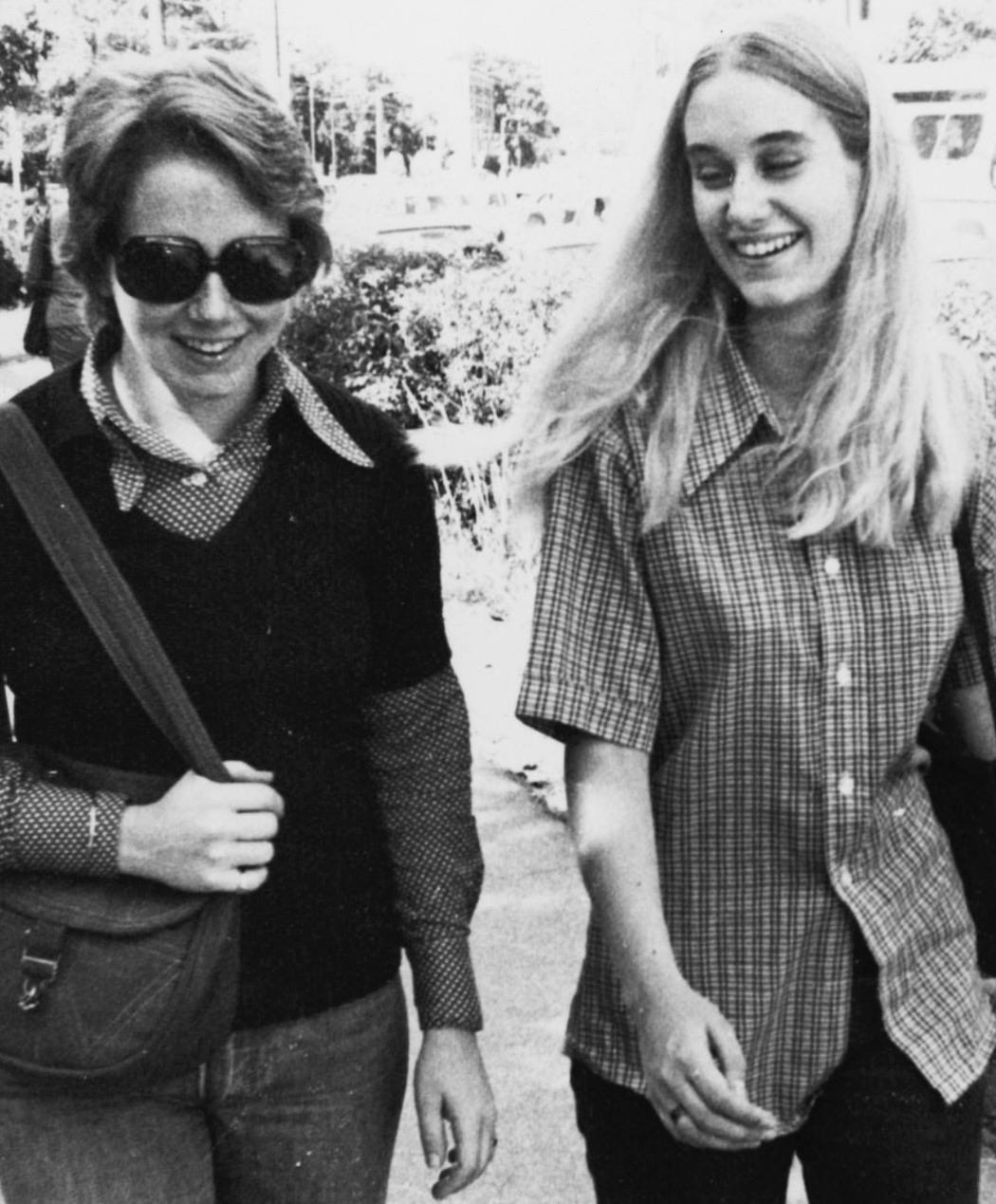(Barbara. and Anne, in the Galapagos, 2022)
Mr. Brown, my freshman algebra teacher with a fondness for colorful Madras sport coats, had his own unique take on statistics, which he shared with us early on in the course.
“Don’t believe what they tell you about the chances of something happening,” he told the class. “The chances of this ceiling caving in during the next five minutes are fifty-fifty. Either it will, or it won’t.”
Mr. Brown probably knew very well this wasn’t how numbers worked, but we were high school fresh freshmen, the lowest of the low, and nobody quite had the nerve to challenge him. Besides, he was a varsity coach, with algebra as a sideline, so who really knew for certain what he might believe?
I, for one, have always been fond of “what are the chances?” stories. They add a wild card to our destiny which makes life more interesting.
Some of you know I met my wife when she drove 1,000 miles from Houston and accepted a reporting job at The Indianapolis News, where I was also a journalist. She had never been to my city before and had no intention of staying long. She only wanted a temporary landing spot while she pondered her next move.
Much to her surprise, that next move included getting engaged two months later, getting married four months after that, and chasing our dreams all over the world for the next half-century. The full story of this whirlwind romance has been written and will soon be shared right here under the headline, “Beer Party Bride Held in Torso Slaying.”
Statistics: there were 180 million people in the U.S. back then, 1,500 newspapers and 50 U.S. states. The chances of our finding each other should have been non-existent. And yet, it happened. To us.
Here is a pretty amazing story for you. Say hello to two sweet, smart Southern girls. We’ll call them Anne and Barbara, because, well, those are their names.
Anne is a Texas blue-eyed blonde belle who lives in Amarillo, Texas for her entire young life until she grows weary of watching tumbling tumbleweeds drift across the road and goes off to study at Harvard. Yes, the Harvard.
Anne’s first cousin, Barbara, is considerably more mobile in her youth. Born in Dallas, she lives in Little Rock, Jackson, New Orleans, and Denver before settling just outside New York City to spend her teenage years. Anne and Barbara are very close. Their mothers are sisters, and their families do family things together throughout their young lives.
(Barbara and Anne, back in the day)
Anne and Barbara have another thing in common. Neither of them has ever had anything whatsoever to do with the American Midwest. Maybe they speed through it now and then to get from the Deep South to the Elitist Northeast, but they don’t stop.
But then, as I mentioned, at age 23 Barbara lands in Indianapolis purely through happenstance, and soon finds herself married. Her new husband, Bob – that’s me - has lived there for his entire life, and he tells his bride that he can’t wait to get the hell out. Neither can she.
After a few years of knocking around, paying their dues and taking some detours, the couple scores good journalism jobs in New York City. Huzzah!
Let’s now return to Anne, who meets a guy named David at Harvard, then she moves to Washington, DC for law school, and reconnects with him. By then, David has become a lawyer for the U.S. Senate. They fall in love. Coincidentally, David is from Indianapolis. All Anne knows about that place is that Barbara and Bob hated it and got out just as fast as their legs could carry them.
Indianapolis back then was a city of below-average museums and an above-average collection of war memorials. The author Kurt Vonnegut, who was from Indianapolis and eventually came to speak very highly of the place, said the city had “Two more war memorials than there have been wars.” Indy had a history of small-town thinking, political ultra-conservatism and a general xenophobia that it wore as a badge of honor.
So, Anne and David are getting serious enough about each other that it seems like Bob and Barbara should drop down to DC to meet him. Anne knows that Bob and David are both from the same city, which has around a million residents. Remember that number. One million people, and yet here is our very first conversation:
“So, David, Anne tells me you’re from Indianapolis. Where did you go to high school?”
“I graduated from Broad Ripple.”
“Wow, so did I.”
“What year?”
“1965.”
“Oh? My brother, Jerry, was in that same class.”
“Jerry Johnson is your brother? We worked together on the school newspaper! What year did you graduate?”
“1970.”
“My little sister, Susie, was there at the same time.”
“Susie Basler is your sister? I knew her!”
Statistics: Indianapolis had more than a dozen public high schools, plus numerous religious and private high schools, and David and I each might have gone to any one of them.
More statistics: The United States of America had well over 20,000 high schools, and we could have gone to any one of those, for that matter. I don’t have a number for how many first cousins there were east of the Mississippi River. I can look into it if you think it’s important, but I believe the figures I’ve already given you are mind-boggling enough.
Anne and David get married and move to Indianapolis, and watch the city steadily improve as a place to live and work. It improves so much that decades later, when Barbara visits Anne, she notes that it is no longer a stinking neanderthal cesspool, and she and Bob move back there after a 47-year absence, living happily ever after.
I honestly never figured out how to process these intricate and interlocking details. Was it part of some grand plan, or just a cosmic roll of the dice? Was Mr. Brown right all along? Maybe I should dispense with calculating the odds against Barbara and Bob and Anne and David all connecting, and figure that it was either going to happen or it wasn’t.
Postscript: Bob and Barbara buy a Tudor Revival home in a historic section of Indianapolis. They buy it online because there is a global pandemic going on. When they move in, they meet their new neighbor, Sandy.
It turns out Bob and Sandy went to the same church as teenagers, and were friends back in their formative years. Indianapolis has some 3,000 churches, more per capita than any other American city. In spite of those daunting odds, Bob and Sandy went to the very same one, and, well, you can see where I’m going with this…
Hit Parade - Most popular 5 a.m. Stories since March 20:






So I dated the aforementioned Jerry Johnson at Hanover College in 1966-67. He dumped me and disappeared from my life until 2003 when as a prospective trustee of Hanover he met my son who was a student. Jerry and I were married in 2008. What are the chances that Jerry would meet my son? I surmise that there may be an aura around men who graduated from Broad Ripple High School.
Maybe everyone who has ever lived in Indy who are roughly in the same demographic cohort have some two degrees of separation from each other. I’m thinking of you and my former Businessweek colleague David Pengilly going to the same camp, which a former vice president also attended. What are the chances?